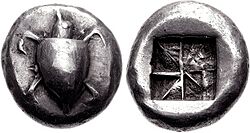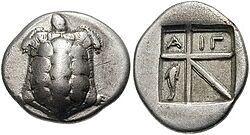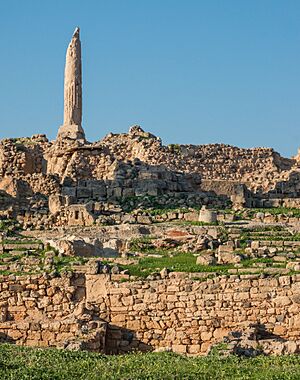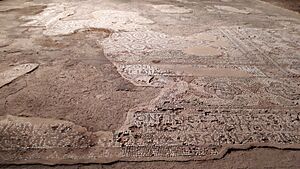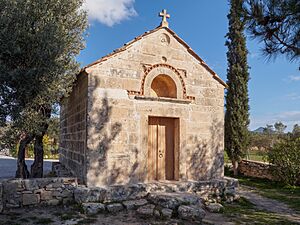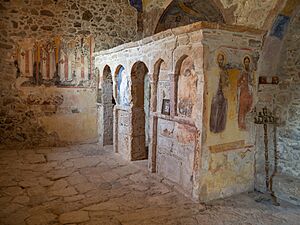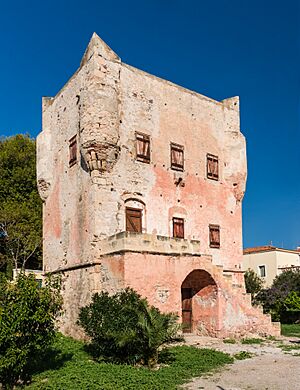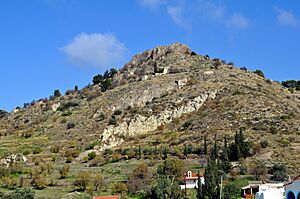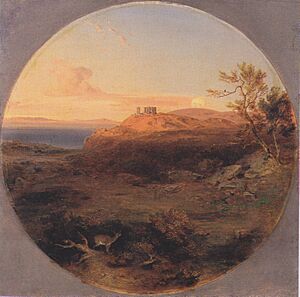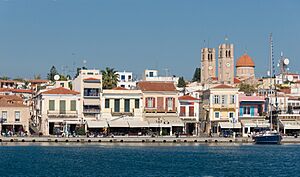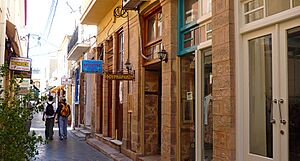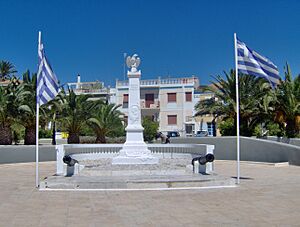Aegina facts for kids
Quick facts for kids
Aegina
Αίγινα
|
||
|---|---|---|

View of Aegina's seafront
|
||
|
||
| Country | Greece | |
| Administrative region | Attica | |
| Regional unit | Islands | |
| Area | ||
| • Municipality | 87.41 km2 (33.75 sq mi) | |
| Population
(2021)
|
||
| • Municipality | 12,911 | |
| • Municipality density | 147.706/km2 (382.56/sq mi) | |
| Community | ||
| • Population | 6,976 (2021) | |
| Time zone | UTC+2 (EET) | |
| • Summer (DST) | UTC+3 (EEST) | |
| Postal code |
180 10
|
|
| Area code(s) | 2297 | |
| Vehicle registration | Υ | |
| Website | Official Visitors Guide to Aegina: http://www.discoveraegina.gr/ | |
Aegina (/ɪˈdʒaɪnə/; Greek: Αίγινα, Aígina; Ancient Greek: Αἴγῑνα) is a beautiful Greek island located in the Saronic Gulf. It's about 27 kilometers (17 miles) away from Athens. People say the island got its name from Aegina, a mythological mother whose son, Aeacus, was born and became king here.
Contents
- Island Government and Communities
- Island Geography and Nature
- Island Climate
- Island History
- Early Times: Bronze Age
- Middle Bronze Age Discoveries
- Late Bronze Age and Mycenaean Culture
- Iron Age and Early Leagues
- Aegina's Decline
- Later Rulers: Hellenistic and Roman Periods
- Byzantine Era
- Frankish Rule (After 1204)
- Venetian Rule (1451–1537)
- First Ottoman Period (1540–1687)
- Second Venetian Period (1687–1715)
- Second Ottoman Period (1715–1821)
- Greek Revolution
- Important Landmarks
- Island Economy
- Island Culture
- Historical Population Numbers
- See Also
- Images for kids
Island Government and Communities
Aegina's Municipality
The municipality of Aegina includes the main island and a few smaller islands nearby. It's part of the Islands regional unit in the Attica area. The municipality is divided into five communities, each with its own population (as of 2021):
- Aegina (6,976 people)
- Kypseli (2,166 people)
- Mesagros (1,473 people)
- Perdika (847 people)
- Vathy (1,449 people)
The main town, also called Aegina, is on the northwest side of the island. Because it's so close to Athens, many people from Athens have second homes here and visit for holidays, especially in summer. The buildings in Aegina town often show a mix of old Greek (Neoclassical) and traditional local styles from the 1800s.
Past Province of Aegina
The area known as the Province of Aegina used to be part of the Attica Prefecture. It was created in 1833 and included the islands of Aegina and Agkistri. This province existed until 2006 when it was no longer used as an administrative division.
Island Geography and Nature
<mapframe latitude="37.7235" longitude="23.4819" zoom="10" width="200" height="131" align="left" /> Aegina is shaped a bit like a triangle. It's about 15 kilometers (9.3 miles) wide from east to west and 10 kilometers (6.2 miles) long from north to south. Its total area is about 87.41 square kilometers (33.75 square miles).
Two-thirds of Aegina is made up of an extinct volcano. The northern and western parts have rocky but fertile plains. Farmers grow grains, some cotton, vines, almonds, olives, and figs here. But the most famous crop on Aegina today is the pistachio. Fishing for sponges used to be very important for the island's economy. The southern part of the island, where the volcano is, is rough and mountainous, with less plant life. The highest point is Mount Oros, which is 531 meters (1,742 feet) tall.
Aegina's beaches are very popular with tourists. You can get to Aegina from Piraeus (near Athens) by hydrofoil in just 40 minutes, or by a regular ferry in about an hour. Ferry tickets for adults usually cost between 4 and 15 euro. There are also regular bus services from Aegina town to other places on the island, like Agia Marina. Portes is a small fishing village on the east coast.
Island Climate
Aegina has a hot semi-arid climate, which means it's generally hot and dry. The average temperature is around 20.0°C (68°F) each year, and it gets less than 340 mm (13 inches) of rain annually.
| Climate data for Aegina | |||||||||||||
|---|---|---|---|---|---|---|---|---|---|---|---|---|---|
| Month | Jan | Feb | Mar | Apr | May | Jun | Jul | Aug | Sep | Oct | Nov | Dec | Year |
| Record high °C (°F) | 25.6 (78.1) |
24.2 (75.6) |
24.6 (76.3) |
29.6 (85.3) |
34.8 (94.6) |
40.2 (104.4) |
42.5 (108.5) |
43.4 (110.1) |
37.1 (98.8) |
31.6 (88.9) |
29.9 (85.8) |
23.4 (74.1) |
43.4 (110.1) |
| Mean daily maximum °C (°F) | 14.1 (57.4) |
15.4 (59.7) |
17.2 (63.0) |
21.4 (70.5) |
25.9 (78.6) |
30.8 (87.4) |
33.8 (92.8) |
33.5 (92.3) |
29.1 (84.4) |
24.0 (75.2) |
19.9 (67.8) |
15.6 (60.1) |
23.4 (74.1) |
| Daily mean °C (°F) | 11.5 (52.7) |
12.6 (54.7) |
13.9 (57.0) |
17.3 (63.1) |
21.5 (70.7) |
26.0 (78.8) |
29.1 (84.4) |
29.3 (84.7) |
25.5 (77.9) |
21.0 (69.8) |
17.2 (63.0) |
13.3 (55.9) |
19.9 (67.7) |
| Mean daily minimum °C (°F) | 9.0 (48.2) |
9.8 (49.6) |
10.6 (51.1) |
13.2 (55.8) |
17.1 (62.8) |
21.2 (70.2) |
24.5 (76.1) |
25.0 (77.0) |
21.8 (71.2) |
18.0 (64.4) |
14.6 (58.3) |
10.9 (51.6) |
16.3 (61.4) |
| Record low °C (°F) | −0.4 (31.3) |
1.2 (34.2) |
1.2 (34.2) |
5.8 (42.4) |
12.4 (54.3) |
14.7 (58.5) |
18.6 (65.5) |
20.8 (69.4) |
14.8 (58.6) |
12.2 (54.0) |
6.8 (44.2) |
2.7 (36.9) |
−0.4 (31.3) |
| Average rainfall mm (inches) | 50.8 (2.00) |
25.9 (1.02) |
25.2 (0.99) |
18.0 (0.71) |
8.0 (0.31) |
17.6 (0.69) |
4.7 (0.19) |
6.8 (0.27) |
45.8 (1.80) |
27.1 (1.07) |
55.9 (2.20) |
50.7 (2.00) |
336.5 (13.25) |
| Source: National Observatory of Athens Monthly Bulletins (Dec 2013 - Feb 2024) and World Meteorological Organization | |||||||||||||
Island History
Aegina was once a colony of Epidaurus, a state in ancient Greece. Because it was located between Attica and the Peloponnesus, it became an important trading spot very early on.
Early Times: Bronze Age
The most important settlement in the Early Bronze Age was Kolonna, a fortified site built with stone. People living here had strong connections with mainland Greece, but also with the Cyclades islands and Crete. Archaeologists have found ancient gold and silver jewelry here, and excavations are still ongoing.
Middle Bronze Age Discoveries
Pottery from the Minoan civilization has been found on Aegina, dating back to around 2000 BC. The famous Aegina Treasure, a collection of beautiful jewelry now in the British Museum, is thought to be from between 1700 and 1500 BC. A workshop for making Tyrian purple dye, a very valuable color, was also found, dating to the 16th century BC.
Late Bronze Age and Mycenaean Culture
Many gold ornaments found on the island show that Mycenaean culture thrived in Aegina even after the Dorians conquered nearby areas. A Mycenaean refuge (a safe place) has also been found on Mount Ellanio, dating to the end of the Late Bronze Age.
Iron Age and Early Leagues
It's believed that the island became influenced by the Dorians around the 9th century BC. Aegina was part of the Amphictyony of Calauria, a league of city-states formed around the 8th century BC. This group, which included Athens and other cities, likely worked together to stop piracy in the Aegean Sea. Aegina also seems to have been part of the Eretrian league during the Lelantine War in the 7th century BC.
Aegina's Coins and Sea Power
Aegina was very important for sea trade even before the Dorians arrived. It's said that Pheidon of Argos started a mint (a place to make coins) in Aegina. This made Aegina the first city-state in Europe to make its own coins! One of the earliest coins, an electrum stater with a turtle on it (turtles were sacred to Aphrodite), dates back to 700 BC. This means Aegina was one of the first places in the Western world to use coins.
Aegina's system of weights and measures, developed in the mid-7th century BC, was one of the two main systems used in the Greek world. This shows how important the island was for trade. The Aeginetic stater weighed about 12.2 grams and was divided into two drachmae. Early coins showed a sea-turtle, but by the end of the 5th century BC, they showed a land tortoise.
During its time as a major sea power, Aegina's ships traveled to many Mediterranean ports. Aegina was also one of only three main Greek states that traded at Naucratis in Egypt. At the beginning of the 5th century BC, Aegina was a key center for the Pontic grain trade. Unlike some other trading states, Aegina didn't establish many colonies.
Rivalry with Athens
Aegina's history is closely tied to its relationship with Athens. Athens began to challenge Aegina's sea power around the early 6th century BC. Solon, a famous Athenian leader, even passed laws to limit Aegina's trade in Attica.
There was a long-standing conflict between the two states. One story says it started over statues of goddesses that the Aeginetes took from Epidaurus. The Athenians tried to get them back, leading to more conflict.
In the early 5th century BC, the Thebans asked Aegina for help against Athens. Aegina formed an alliance and attacked the coast of Attica. Athens planned to fight back, even though the Delphic oracle advised them to wait 30 years. Their plans were interrupted by Sparta.
In 491 BC, Aegina was one of the states that gave "earth and water" (symbols of surrender) to Achaemenid Persia. Athens asked Sparta to punish Aegina for this. Later, the Aeginetes captured some Athenians, and Athens tried to get revenge by helping a democratic leader on Aegina, but the plan failed.
The war between Athens and Aegina was very important. Athens decided to build a large fleet of 200 warships "for the war against Aegina" around 483–482 BC, showing how serious the conflict was. Aegina was a strong naval power during this time.
Aegina's Decline
During the Greco-Persian Wars, Aegina played a significant role in defeating Xerxes I's Persian fleet, especially at the Battle of Salamis. They were even awarded the prize for bravery at Salamis. However, after this, Aegina's power began to decline.
Athens' foreign policy changed, leading to the First Peloponnesian War. Aegina was forced to surrender to Athens after a siege around 456 BC and became a subject-ally, meaning they had to pay tribute. By the terms of the Thirty Years' Peace (445 BC), Athens promised to give Aegina its independence back, but this didn't happen.
During the first winter of the Peloponnesian War (431 BC), Athens expelled the Aeginetans from their island. The exiles settled in Thyreatis. Later, a force led by Nicias attacked them there, and many lost their lives. At the end of the Peloponnesian War, Lysander helped the remaining Aeginetans return to the island.
Aegina's greatness came from its trade, especially with the East, which suffered greatly from wars. The loss of trade and the decline of its navy led to the island's power fading.
Later Rulers: Hellenistic and Roman Periods
Like the rest of Greece, Aegina was ruled by different empires over time:
- The Macedonians (322–229 BC)
- The Achaeans (229–211 BC)
- The Aetolians (211–210 BC)
- Attalus of Pergamum (210–133 BC)
- The Romans (after 133 BC)
A Jewish community was established in Aegina around the 2nd and 3rd centuries AD. They built a beautiful synagogue with a mosaic floor, which was used until the 7th century AD. Local Christian stories say that a Christian community started here in the 1st century, with Crispus, a leader from the Corinthian synagogue, as its first bishop.
Byzantine Era
After the Roman Empire split in 395 AD, Aegina became part of the East Roman (Byzantine) Empire. The island became a refuge for people fleeing invasions from the mainland. Aegina thrived in the early 9th century, with many churches being built. However, it suffered from raids by Arabs from Crete. Many people fled to the Greek mainland, and some moved inland on the island, creating the settlement of Palaia Chora. By the 12th century, Aegina was known as a base for pirates.
Frankish Rule (After 1204)
After the Byzantine Empire was divided in 1204, Aegina was given to the Republic of Venice. However, it ended up being controlled by the Duchy of Athens. The Catalan Company took over Athens and Aegina in 1317. In 1425, the island came under Venetian control again to protect it from Turkish attacks. The island was productive, and Venice required it to supply grain to its colonies.
Venetian Rule (1451–1537)
In 1451, Aegina officially became Venetian. The islanders were happy with Venetian rule. A Venetian governor was appointed, reporting to authorities in Nauplia. To help pay for defenses, Aegina reluctantly gave up a valuable relic, the head of St. George, which was moved to Venice. In return, the Venetians gave the Aeginetes money to fortify the island.
In 1537, Sultan Suleiman declared war on Venice. His admiral, Hayreddin Barbarossa, attacked Aegina in October. The town of Palaiochora was captured, and many people were captured or lost their lives.
First Ottoman Period (1540–1687)
Aegina suffered greatly after Barbarossa's attack in 1537. In 1579, the island was partly repopulated by Albanians, who later became part of the Greek population. The island was attacked again and left desolate by Francesco Morosini during the Cretan War in 1654.
Second Venetian Period (1687–1715)
In 1684, the Morean War began between Venice and the Ottoman Empire. Venice temporarily took back many areas, including Attica in 1687. Many Athenians moved to Aegina during a plague epidemic in 1688. In 1693, Morosini refortified Aegina's castle. By the peace of Karlowitz in 1699, Venice kept Aegina and several other islands.
Second Ottoman Period (1715–1821)
During the Ottoman–Venetian War of 1714–1718, the Ottoman fleet captured Aegina. Ottoman rule was confirmed by the Treaty of Passarowitz. They controlled the island until the Greek War of Independence began in 1821, except for a short Russian occupation in the early 1770s.
Greek Revolution
During the Greek War of Independence, Aegina became an important administrative center for the Greek revolutionaries. Ioannis Kapodistrias, who became the first leader of modern Greece, was briefly based here.
Important Landmarks
- Temple of Aphaea: This ancient temple, built around 490 BC, is the oldest surviving temple in Greece. It was dedicated to Aphaea, a goddess later linked with Athena. This temple was part of a special triangle of holy temples, along with the Athenian Parthenon and the temple of Poseidon at Sounion.
- Monastery of Agios Nectarios: This monastery is dedicated to Nectarios of Aegina, a modern saint of the Greek Orthodox Church.
- Ioannis Kapodistrias Statue: In the main square, there's a statue honoring Ioannis Kapodistrias (1776–1831), who was the first leader of modern, independent Greece.
- The Orphanage of Kapodistrias: This large building, locally known as The Prison, was built in 1828-29 by Ioannis Kapodistrias. It was originally a home for children who lost their parents during the Greek War of Independence. Over time, it also housed schools, workshops, the National Public Library, a museum, a military academy, and a printing office. From about 1880, it was used as a prison, which is how it got its local name. There are plans to restore it as a museum.
- The Tower of Markellos: This tower was likely built during the second Venetian rule (1687–1714) as a watchtower against Turkish attacks. It was later bought by revolutionary leader Spyros Markellos. From 1826-28, it served as the headquarters for the early Greek government. Today, it belongs to the Municipality of Aegina.
- Temple of Zeus Hellanios: Near the village of Pachia Rachi, you'll find a 13th-century Byzantine church. It was built on the ruins of an ancient temple dedicated to Zeus Hellanios from the 4th century BC. You can still see parts of the original walls and staircase.
- Colona: Located north of Aegina town, this was an ancient acropolis with a sanctuary dedicated to Apollo and a later Byzantine settlement. Venetian sailors named it "Colona" (column) because they used the columns of the ancient Doric temple of Apollo as a landmark. Today, you can see the foundations and one column of this temple. This area was a very important commercial center in ancient times.
Island Economy
Aegina Pistachios
In 1896, a doctor named Nikolaos Peroglou started growing pistachios on the island in an organized way. This crop quickly became very popular. By 1950, pistachio farming had largely replaced other types of farming because it was very profitable. In the early 1960s, the first pistachio processing factory was built.
The quality of "Fistiki Aeginis" (Aegina Pistachios) is known worldwide as excellent. This is because of the island's special climate (dry weather) and volcanic soil. "Fistiki Aeginis" even has a special status as a "Protected Designation of Origin" product since 1996. Pistachios have made Aegina famous around the globe. Today, about half of the pistachio farmers are part of the Agricultural Cooperative of Aegina's Pistachio Producers. Pistachio farms cover about 29,000 acres of the island, producing around 2,700 tons each year. Every September, the island hosts the "Fistiki Fest", a festival celebrating the pistachio.
Island Culture
Greek Mythology and Aegina
In Greek mythology, Aegina was the daughter of the river god Asopus and the nymph Metope. She had two children: Menoetius with Actor, and Aeacus with the god Zeus. When Zeus took Aegina away, he brought her to an island called Oenone, near Attica. Here, Aegina gave birth to Aeacus, who later became king of Oenone. After that, the island was named Aegina.
Aegina was also the training ground for the Myrmidons. Zeus needed a strong army, and he thought Aegina, which had no villagers at the time, was a good place. So, he changed some ants (Ancient Greek: Μυρμύγια, Myrmigia) into warriors with six hands and black armor. Later, these Myrmidons, led by Achilles, became known as the bravest fighting unit in Greece.
Famous People from Aegina
- Aeacus: The first king of Aegina in mythology.
- Smilis (6th century BC): A sculptor.
- Sostratus of Aegina (6th century BC): A merchant.
- Onatas (5th century BC): A sculptor.
- Ptolichus (5th century BC): A sculptor.
- Philiscus of Aegina (4th century BC): A Cynic philosopher.
- Paul of Aegina (7th century): A medical scholar and physician.
- Saint Athanasia of Aegina (9th century): An abbess and saint.
- Theodora of Thessaloniki (9th century): A nun and saint.
- Cosmas II Atticus (12th century): A Patriarch of Constantinople.
- Nectarios of Aegina (1846–1920): A bishop and saint.
- Aristeidis Moraitinis (aviator) (born 1891, died 1918).
- Gustav Hasford: An American writer who lived and passed away in Aegina in 1993.
Historical Population Numbers
| Year | Town population | Municipal/Island population |
|---|---|---|
| 1981 | 6,730 | 11,127 |
| 1991 | 6,373 | 11,639 |
| 2001 | 7,410 | 13,552 |
| 2011 | 7,253 | 13,056 |
| 2021 | 6,633 | 12,911 |
See Also
- Flag of Aegina
Images for kids





